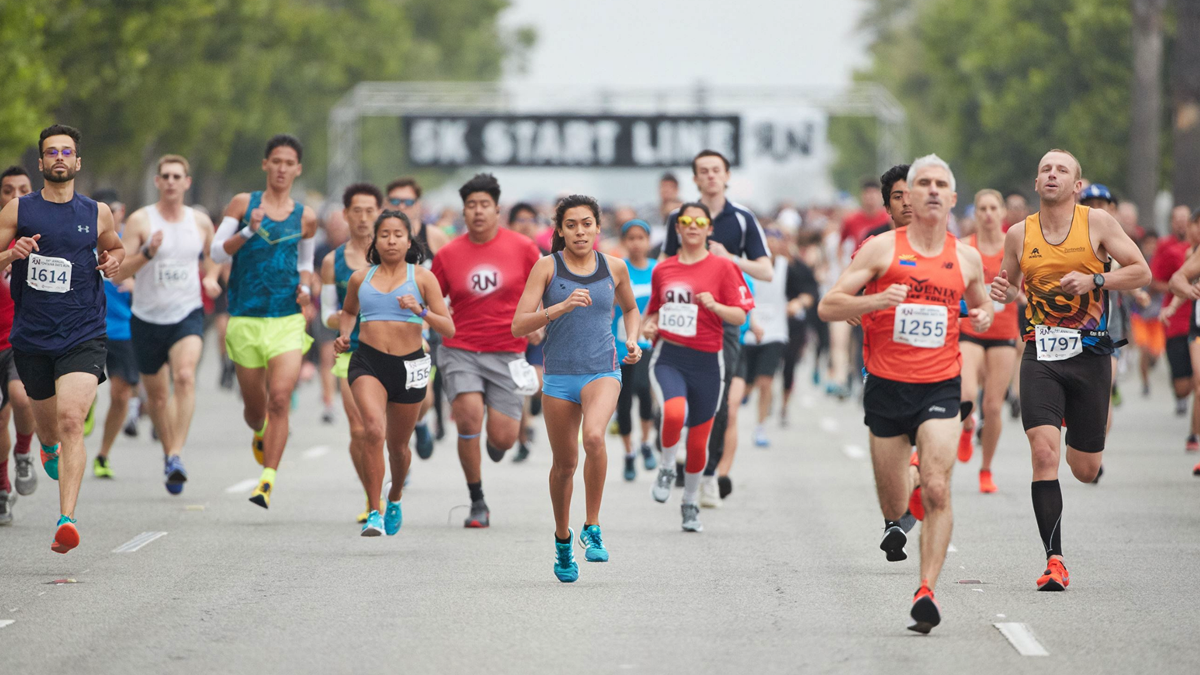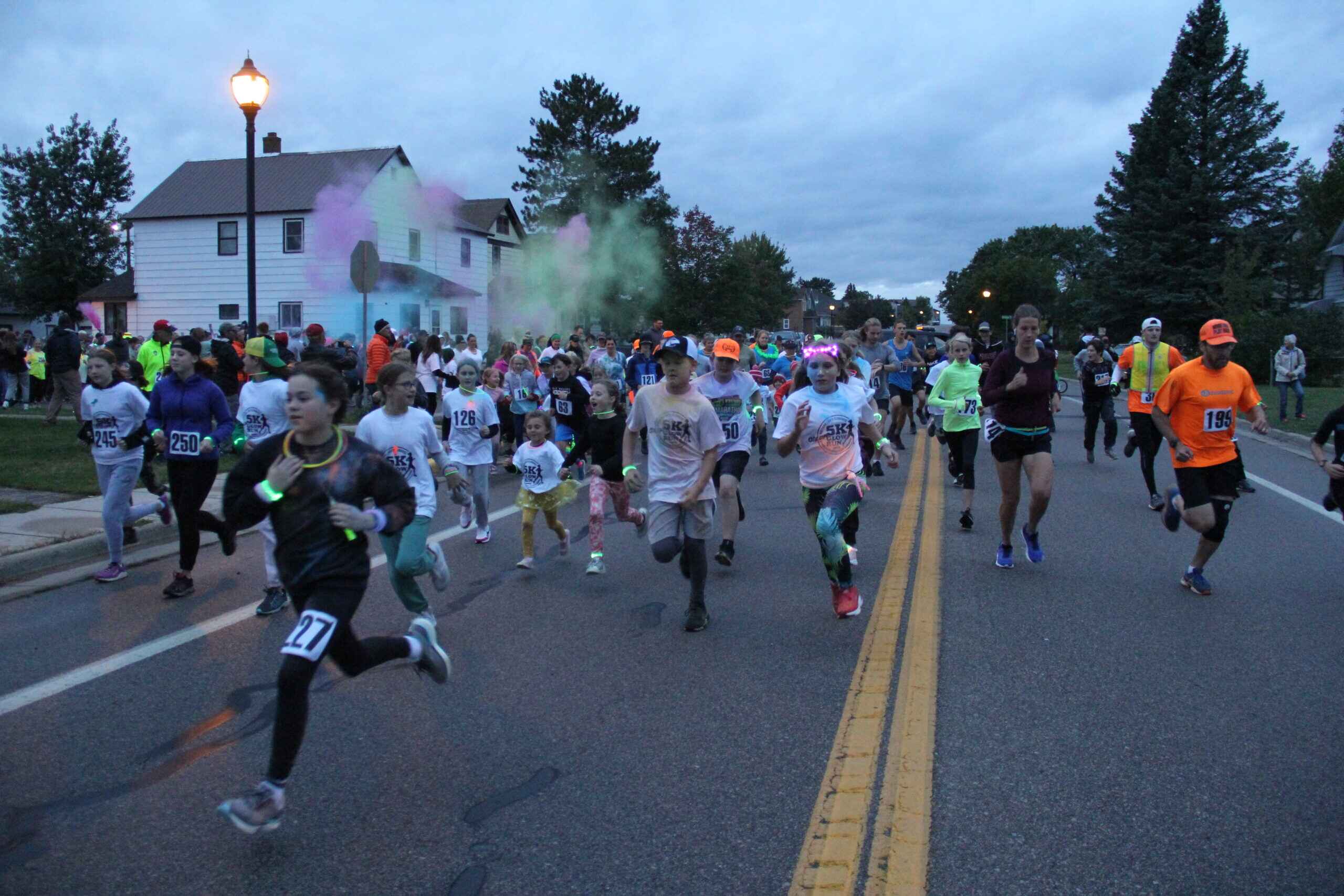

Featured
How Much Does A 5K Run Cost To Host
Published: August 12, 2023
Looking to host a 5K run? Find out the cost of hosting a featured event and plan your budget with our comprehensive guide.
Introduction
Hosting a 5K run can be a thrilling and rewarding experience, bringing together participants of all ages and fitness levels for a fun and challenging event. However, before embarking on this endeavor, it is important to consider the financial aspects involved. Planning and organizing a successful 5K run requires careful budgeting and cost analysis to ensure that the event runs smoothly and meets its objectives.
From venue rentals to participant amenities, there are several factors that contribute to the overall cost of hosting a 5K run. In this article, we will explore the various expenses involved in organizing a 5K run and provide insights into how much you can expect to spend on each aspect. By understanding the financial implications, you will be better equipped to create a realistic budget and make informed decisions throughout the planning process.
It is important to note that the cost of hosting a 5K run can vary significantly depending on several factors, such as the location, the scale of the event, the number of participants, and the goals of the event organizers. However, the following breakdown of expenses will give you a general idea of what to expect when planning your own 5K run.
So, if you’re ready to dive into the financial aspects of hosting a 5K run, let’s explore the various expenses involved and gain a better understanding of what it takes to create an unforgettable event for both participants and organizers.
Venue Rental Costs
One of the most significant expenses when hosting a 5K run is the rental cost of the venue where the event will take place. The venue serves as the central location for the start and finish lines, as well as providing space for pre and post-race activities. The cost of renting a venue can vary greatly depending on the location and the facilities provided.
In urban areas or popular event destinations, venue rental costs tend to be higher compared to smaller towns or less sought-after locations. Additionally, the size of the venue and the amenities it offers can also impact the rental cost. Venues that provide access to on-site parking, restrooms, changing facilities, and other amenities may come at a higher price.
When budgeting for venue rental costs, consider the duration of the event. Some venues charge an hourly rate, while others have a flat fee for the entire day. Be sure to account for any additional time needed for setup and teardown activities.
To keep costs down, consider alternative venues such as public parks or recreational areas that may offer affordable or even free options for hosting a 5K run. However, keep in mind that additional permits or insurance may be required for utilizing public spaces.
Lastly, remember to factor in any additional costs associated with the venue, such as security fees or the cost of any necessary permits. These expenses can vary depending on local regulations and requirements, so it is essential to research and understand the specific requirements of your chosen venue.
Overall, venue rental costs can significantly impact the budget of your 5K run. Properly researching and planning for this expense will help ensure you have a suitable location for your event while staying within your budget constraints.
Permits and Insurance Fees
When organizing a 5K run, obtaining the necessary permits and insurance coverage is crucial to ensuring the event runs smoothly and complies with local regulations. These requirements vary depending on the location and the specific details of the event, and failure to adhere to them can result in legal issues or the cancellation of the event.
Permits are typically required for road closures, traffic management, and the use of public spaces. The cost of permits can vary depending on the size of the event, the duration of the road closures, and any additional services required, such as police or traffic control personnel.
Insurance coverage is another essential cost to consider when hosting a 5K run. This includes general liability insurance to protect against potential accidents or injuries that may occur during the event. The cost of insurance will depend on factors such as the number of participants, the level of risk associated with the event, and the coverage limits required.
It is vital to work closely with the local authorities and insurance providers to understand the specific requirements and obtain the appropriate permits and insurance coverage. Failure to do so can result in legal consequences and financial liabilities for the organizers.
When budgeting for permits and insurance fees, be sure to consider the time and effort involved in the application process. Some permits may require submitting applications well in advance and going through a review and approval process. It is recommended to start this process early to avoid any last-minute complications.
Additionally, it is crucial to accurately estimate the cost of insurance coverage by seeking quotes from multiple insurance providers. This will help you find the best coverage at a reasonable cost and ensure that your event is adequately protected.
By accounting for permits and insurance fees in your budget, you can ensure that you are compliant with local regulations, minimize legal risks, and provide a safe environment for participants and volunteers during your 5K run.
Race Timing and Chip Systems
Accurately tracking and timing participants is an essential aspect of any 5K run. To ensure fairness and provide accurate results, event organizers often invest in professional race timing and chip systems. These systems use advanced technology to track individual participant times and provide real-time results.
The cost of race timing and chip systems can vary depending on the complexity of the event and the number of participants. For smaller-scale 5K runs, manual timing methods using stopwatches and paper-based recording systems may be sufficient and more cost-effective. However, for larger events or those aiming to provide a more professional experience, electronic chip timing systems are commonly utilized.
Electronic chip timing systems typically involve providing each participant with a small chip or tag that is attached to their shoe or race bib. These chips are then detected by timing mats placed at the start and finish lines, as well as at various checkpoints along the route. As participants cross these mats, their individual times are recorded automatically.
The cost of renting or purchasing race timing and chip systems can vary depending on the number of mats required, the duration of the rental period, and any additional services provided by the timing company, such as live tracking or online result integration.
It is important to consider the logistical aspects of implementing a race timing and chip system. This includes coordinating with the race timing company, setting up the timing equipment at the start and finish lines and ensuring that all participants receive their chips or tags before the event. Additionally, it may be necessary to provide volunteers or hired staff to assist with the timing process.
While race timing and chip systems can be a significant expense, they add professionalism and accuracy to your 5K run, enhancing the overall experience for participants. Proper budgeting and research will help you select the most suitable timing system that aligns with your event requirements and budget constraints.
Event Staffing and Volunteer Expenses
Organizing a 5K run requires a team of dedicated individuals to help with various tasks and ensure the smooth execution of the event. Event staffing and volunteer expenses are an important consideration when budgeting for your 5K run.
Event staffing typically includes hiring professionals to oversee critical areas such as event coordination, logistics, registration, and participant assistance. The number of staff members required will depend on the size and complexity of the event. It is important to carefully assess the staffing needs to ensure that all key areas are adequately covered.
The cost of event staffing can vary based on factors such as the duration of the event, the level of experience and expertise required, and the local market rates for event staff. It is recommended to obtain quotes from multiple staffing agencies or freelancers to find the best fit for your event and budget.
In addition to paid staff, volunteers play a crucial role in the success of a 5K run. They assist with tasks such as race packet pickup, water stations, course marshaling, and participant guidance. While volunteers may not require payment, it is important to consider their expenses, such as t-shirts or other forms of recognition, meals, and transportation. Demonstrating appreciation for volunteers will help foster a positive and supportive environment during the event.
Recruiting and managing volunteers require effective communication and coordination. It is important to clearly define their roles and responsibilities, provide training if necessary, and ensure they have the resources and support they need to carry out their tasks effectively.
When budgeting for event staffing and volunteer expenses, be sure to factor in the number of staff members or volunteers required, any necessary equipment or supplies they may need, and any additional costs associated with recognizing and appreciating their contributions.
By investing in a capable and dedicated event staff and volunteers, you can ensure that your 5K run runs efficiently and provide a positive experience for both participants and organizers.
Marketing and Promotion Costs
An essential aspect of hosting a successful 5K run is effectively marketing and promoting the event to attract participants. Marketing and promotion costs represent a significant portion of the budget and play a crucial role in spreading awareness and generating registrations.
Digital marketing has become increasingly important in recent years. A well-designed and user-friendly event website can serve as the central hub for information and registration. Investing in a professional website design and development can help create a strong online presence and make it easier for potential participants to find and register for the event.
Social media platforms offer powerful tools for marketing and promotion. Running paid advertisements on platforms like Facebook, Instagram, or Twitter can help reach a wider audience and target specific demographics or geographical areas. Additionally, engaging and interactive content creation can help generate buzz and encourage social sharing, further expanding awareness of the event.
Traditional marketing methods should not be overlooked. Printing and distributing flyers, posters, and banners in strategic locations such as local gyms, running stores, and community centers can help reach individuals who may not be active on social media platforms.
Sponsoring and partnering with local businesses and organizations can also be beneficial. They can provide financial support or in-kind donations in exchange for promotional opportunities at the event or through marketing materials. Collaborating with local running clubs or fitness groups can help tap into their networks and attract participants who already have an interest in running events.
When budgeting for marketing and promotion costs, consider expenses such as website development, social media advertising, print materials, and any fees associated with partnering or sponsoring organizations. It is important to allocate a sufficient budget to effectively market the event and ensure a strong turnout.
Monitoring the success of marketing efforts is crucial. Keep track of registration numbers, website traffic, and engagement metrics from social media platforms to evaluate the effectiveness of the marketing strategies implemented. This will help refine future marketing efforts and make informed decisions to maximize impact while staying within budget constraints.
By investing in marketing and promotion, you can increase the visibility and success of your 5K run, attract participants who are passionate about the event, and create a memorable experience for all involved.
Participant Amenities and Swag
Creating a positive and memorable experience for participants is a key goal when hosting a 5K run. Providing amenities and swag not only adds value for participants but also contributes to the overall branding and perception of the event. Consider including participant amenities and swag in your event budget to enhance the participant experience.
Participant amenities may include items such as race t-shirts, race bibs, finisher medals or certificates, and goodie bags. These items not only serve as mementos for participants but can also create a sense of pride and accomplishment. It is important to consider the quality and design of these items to ensure they are well-received by participants.
When budgeting for participant amenities, consider the number of participants and the desired quality of the items. Bulk pricing may be available for larger quantities, and it is worth exploring different suppliers to find the best balance between quality and cost. Additionally, keep in mind any customization or personalization requirements for items such as race bibs or finisher medals.
Sponsorship opportunities can also help offset the cost of participant amenities. Partnering with local businesses or organizations that align with the event’s theme or target audience can provide opportunities for in-kind donations or financial support in exchange for branding or promotional opportunities.
Swag, or promotional merchandise, can further enhance the experience for participants. This may include items such as water bottles, drawstring bags, keychains, or other branded merchandise. Such items not only serve as practical giveaways but also serve as reminders of the event long after it has ended.
When budgeting for swag items, consider the cost of production, customization, and any associated shipping or delivery fees. It may be necessary to order these items well in advance to allow for production time and ensure they are received in time for the event.
As part of the participant amenities, don’t forget to budget for essential on-site amenities such as portable toilets, water stations, and medical aid. These amenities ensure the comfort and safety of participants during the event.
By investing in participant amenities and swag, you can enhance the overall experience and leave a lasting impression on participants. Well-thought-out and high-quality items can create a sense of value and appreciation, encouraging participants to not only participate in future events but also spread the word about their positive experience.
Refreshments and Water Stations
Ensuring that participants are adequately hydrated and nourished during a 5K run is crucial for their well-being and performance. Providing refreshments and strategically placed water stations along the course are important considerations when budgeting for your event.
Water stations are key points along the race route where participants can replenish their fluids. These stations typically consist of tables with cups or bottles filled with water and are manned by volunteers or staff members. The number of water stations required will depend on the length of the course, the weather conditions, and the expected number of participants.
When budgeting for water stations, consider the cost of purchasing water, cups, and any additional supplies needed, such as tables, signage, or trash bins. You may also need to provide amenities like hand sanitizers or cooling mister fans, depending on the event’s location and weather conditions.
In addition to water, it is also beneficial to provide other refreshments for participants. This can include sports drinks to replenish electrolytes, fresh fruits, energy bars, or small snacks. These refreshments can help participants maintain their energy levels and optimize their performance during the event.
When budgeting for refreshments, consider the number of participants and the desired variety and quality of the items. Partnering with local businesses or sponsors can help offset costs by providing in-kind donations or financial support in exchange for branding or promotional opportunities.
It is also essential to consider special dietary requirements or restrictions. Offering options for participants with dietary restrictions or preferences, such as gluten-free or vegan options, can enhance inclusivity and participant satisfaction.
Proper logistics and coordination are crucial for the successful implementation of refreshments and water stations. This includes planning the placement of water stations along the course, ensuring they are well-stocked and easily accessible, and coordinating with volunteers or staff members who will be managing these stations.
By providing well-placed water stations and refreshing snacks, you can help participants stay hydrated, energized, and motivated throughout the event. These amenities not only enhance the participant experience but also contribute to their overall safety and well-being. Proper budgeting and planning will ensure you can provide these essential services without straining your overall budget.
Awards and Medals
Acknowledging the achievements of participants is an important aspect of hosting a 5K run. Providing awards and medals adds an element of competition and recognition to the event. Budgeting for awards and medals not only motivates participants to perform their best but also adds a sense of prestige and accomplishment to the overall experience.
Awards can be given in various categories, such as overall winners, age group winners, or team awards. The number and type of awards will depend on factors such as the number of participants and the depth of competition.
When budgeting for awards, consider the cost of purchasing or customizing trophies, plaques, or certificates. It may also involve engraving or printing costs to personalize the awards with the recipients’ names or event details.
Medals are another popular form of recognition and are often given to all participants upon completing the 5K run. These medals serve as tangible reminders of their achievement and can be cherished for years to come.
When budgeting for medals, consider the quantity needed based on the expected number of participants. The cost will vary depending on the material, design, and customization options chosen for the medals. Bulk pricing may be available for larger quantities, so it’s worth exploring different suppliers to find the best balance between quality and cost.
Additionally, consider the presentation of the awards and medals. Providing a podium for winners to stand on during the awards ceremony adds an extra level of excitement and visual impact. Designing or ordering branded backdrop banners or signage can also enhance the overall aesthetic of the awards ceremony.
Sponsorship opportunities can help defray the cost of awards and medals. Local businesses or organizations may be interested in sponsoring specific award categories in exchange for promotional opportunities and visibility at the event.
Proper planning and coordination are essential to ensure that the awards and medals are ready on time and presented in a meaningful and organized manner. This includes determining the criteria for each award category, preparing certificates or plaques, and organizing the awards ceremony.
By budgeting for awards and medals, you can add a competitive and celebratory element to your 5K run. Recognizing and rewarding participants’ achievements not only boosts their motivation but also adds value and excitement to the overall event experience.
Equipment and Supplies
When planning a 5K run, it is important to budget for the necessary equipment and supplies to ensure a smooth and well-organized event. From registration materials to race-day essentials, having the right equipment and supplies is crucial for a successful event.
Registration materials include items such as race bibs, safety pins, and race packets. Race bibs are typically personalized with participants’ names and assigned numbers, making them an essential component for identification and timing purposes. Safety pins are used to secure the race bibs to participants’ clothing.
Timing equipment, such as timing mats, stopwatches, or electronic chip systems, is needed to accurately track participants’ times and generate race results. Depending on the complexity of the event, you may need to rent or purchase timing equipment and ensure that it is set up properly at the start and finish lines.
Course setup requires equipment such as cones, signage, and barricades to mark the race route, indicating turns, hazards, and any other important information for participants. These items help guide participants along the designated course and ensure safety during the event.
Other supplies to consider include first aid kits and medical equipment in case of emergencies or injuries during the event. It is essential to have trained medical personnel or volunteers available to provide first aid and handle any medical situations that may arise.
Additionally, consider items such as megaphones or sound systems for announcements, tables and chairs for registration, rest areas, or equipment storage, and power sources or generators to ensure electricity supply for timing equipment or sound systems.
When budgeting for equipment and supplies, consider the number of participants, the race route’s complexity, and any specific requirements or regulations set by local authorities. Research and compare prices from different suppliers to find the best deals without compromising quality.
It is also beneficial to create a thorough checklist of all the equipment and supplies needed for the event and ensure that everything is accounted for and properly organized before race day.
By budgeting for the necessary equipment and supplies, you can ensure that your 5K run is well-organized, safe, and successful. Having the right equipment and supplies in place will contribute to a positive experience for both participants and organizers.
Miscellaneous Expenses
When budgeting for a 5K run, it’s important to account for miscellaneous expenses that may arise during the planning and execution of the event. These expenses can vary depending on the specific details of your event, but it is essential to anticipate and allocate funds for unforeseen circumstances.
One such expense is event insurance, which provides coverage in case of accidents, injuries, or damages that may occur during the event. While we covered insurance fees in a previous section, it’s important to also account for any additional coverage or supplemental policies that may be required.
Transportation and logistics can also incur costs. This includes rental fees for vehicles or transportation services needed to transport equipment, supplies, or staff members to and from the event venue. It’s important to factor in these expenses if they are applicable to your event.
If your event involves entertainment or performances, there may be fees associated with hiring musicians, DJs, or other performers. Additionally, you may need to budget for sound and lighting equipment rental, stage setup, or any other technical requirements to support the entertainment portion of your event.
Another potential miscellaneous expense to consider is marketing materials beyond digital or print advertising, such as banners, signage, or promotional merchandise. These items contribute to the branding and visibility of your event and can be distributed or displayed at various locations.
Depending on the scale and nature of your event, security personnel or crowd control services may be necessary. This is particularly important if the event attracts a large number of participants or takes place in a public space. It’s vital to ensure the safety and well-being of participants and attendees.
Finally, contingency funds should be allocated to cover any unexpected last-minute expenses or emergencies that may arise. This provides a cushion to handle unforeseen circumstances and helps you avoid financial strain during the event planning process.
By budgeting for miscellaneous expenses, you can be better prepared for any unexpected costs that may arise during the planning and execution of your 5K run. This proactive approach ensures that your event runs smoothly, minimizes stress, and allows you to focus on creating an unforgettable experience for participants.
Conclusion
Organizing and hosting a 5K run involves careful planning, budgeting, and attention to detail. By understanding the various expenses involved, you can create a comprehensive budget that allows for a successful and memorable event.
Venue rental costs, permits and insurance fees, race timing and chip systems, event staffing and volunteer expenses, marketing and promotion costs, participant amenities and swag, refreshments and water stations, awards and medals, equipment and supplies, and miscellaneous expenses are key factors to consider when budgeting for a 5K run.
Allocating funds for venue rental costs ensures a suitable location for the event, while permits and insurance fees provide legal protection and compliance with local regulations. Race timing and chip systems add professionalism and accuracy to the event while event staffing and volunteers help with various tasks and create a positive experience for participants.
Marketing and promotion costs generate awareness and attract participants, and participant amenities and swag enhance the overall experience. Providing refreshments and water stations ensures participants are hydrated and energized, while awards and medals recognize their achievements.
Properly budgeting for equipment and supplies ensures a well-organized event, and accounting for miscellaneous expenses allows for unforeseen circumstances. By considering these expenses, you can create a realistic budget that covers all aspects of the event and minimizes financial surprises along the way.
Ultimately, the success of your 5K run depends on the careful planning, attention to detail, and effective management of finances. By creating a comprehensive budget and allocating funds appropriately, you can host a successful and memorable event that leaves participants and organizers alike with a sense of accomplishment and satisfaction.
Now that you have a better understanding of the expenses involved in hosting a 5K run, it’s time to start planning, budgeting, and bringing your event to life. With careful financial management and attention to the various aspects covered in this article, you’ll be well on your way to organizing a remarkable 5K run.









